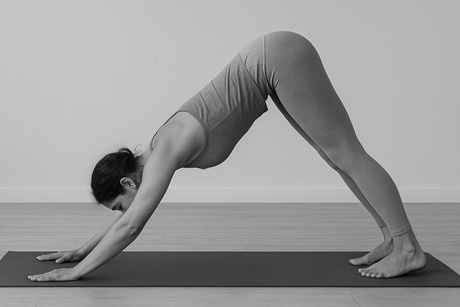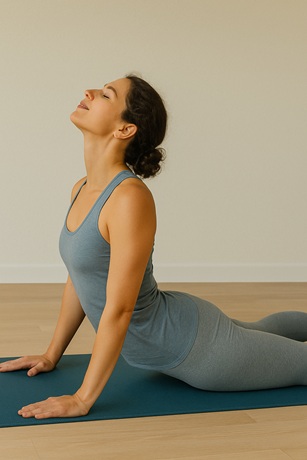Personally, I do Yoga 2-3 times a week. I’m trained in clinical Pilates and taught classes for years. Over lockdown I started yoga and it’s something I’ve been enjoying and benefiting from since. And I think with various spinal conditions you can get a benefit from each. Frequently I’ll prescribe both Yoga and Pilates exercises along with traditional physio exercises to help people mend the movement, strength, and function of there spine. I’m writing this from the perspective of being a Chartered Physio rather than a Pilates instructor or someone who loves yoga.
I’m writing this from the perspective of being a Chartered Physio rather than a Pilates instructor or someone who loves yoga.

Yoga Or Pilates?
Yoga
Yoga has been around for 5,000 years; its origins are linked to spiritual teachings. Maybe your initial thought is “I’m not really into that hippy kind of class” … Yoga has been around so long that there is many branches and different classes to choose from. Some yoga teachers will be heavy on the spiritual side, and some will avoid all the spiritual stuff completely and focus more on relaxing into stretches.
If you’re a modern-day hippy or you just want to keep subtle as you age, then you’ll be able to find the right class for you.
If you’re suffering from a back injury and in recovery, it’s important you let the instructor know before the class begins. And ideally before you book the class. As their class plan may not be appropriate for your injury and if they are going to make a new plan, they’ll need advance notice.

yoga Benifits
Yoga is wonderful for regaining lost ranges of motion, you can give your back a lovely stretch and stretch out all the overactive muscles and tight ligaments. Sometimes as you’re recovering from a back injury your back can be intolerant to long stretch holds where you reach towards your feet. These can trigger a flair and limit your mobility for days. It’s important to get back to doing these movements but in a way and at a rate that your back can tolerate..
Pilates
Pilates is a much more recent invention and dates to 1920, unsurprisingly it was invented by Joseph Pilates (Sorosky et al, 2007). Pilates originally required beds with springs to pull against. Laying down and pulling against springs allowed injured people to work with a fraction of body weight starting off and then as they progressed clients then moved onto to matt-based work. Joseph trained mostly dancers in his studio, and this is where the link to dance comes from, and many Pilates exercises are taught with the technique of pointing the toes like a dancer would.
Joseph Pilates was reportedly highly strung, much like a piece of his exercise equipment. There is tales of him calling into competitors with a gun warning them that if they valued their life, they’d shut their classes down. So, it’s not surprising that his Pilates classes became more popular after he passed away. And it’s not surprising either that there isn’t usually a strong spiritual element to his teachings.
Most Pilates classes start on a matt now, rather than using the big bulky reformer equipment for the first few weeks and months. The reason for this is usually just that most people doing the class are fit enough to start on matt-based work straight away and the large equipment is not very practical unless it’s a very small class.

pilates Benifits
What we love about Pilates exercises is that the coaching for the core and pelvic floor. Especially after childbirth, exercises to work the pelvic floor become so important. And the core exercises can help reduce diastasis (Where the tummy muscles part in the middle). Many people associate this with childbirth, but we see this in as many men who carry weight around their tummy area. The top layer of the tummy muscles gets strained and then splints. The deep core training in Pilates is something that can benefit a whole array of people.
At Glossop Physio we have a clinic based in the heart of Glossop on Norfolk Square, and we offer free physiotherapy consultations, where you get to sit down with a member of our team. Get answers to the questions you have and find out what can be done to help you move and feel better.
When you are ready just give us a call on 07517421800 to organise your free consultation. Or if you like to do things online you can start organising your free consultation by filling out our webform Click Here
Other Free Resources for Your Pain
Click Here To Read – The benefits of activity and exercise for elderly people who want to keep active
On social media? Follow us on Facebook or Instagram
